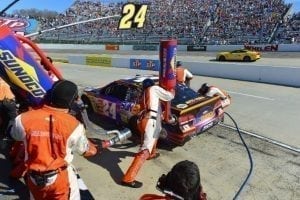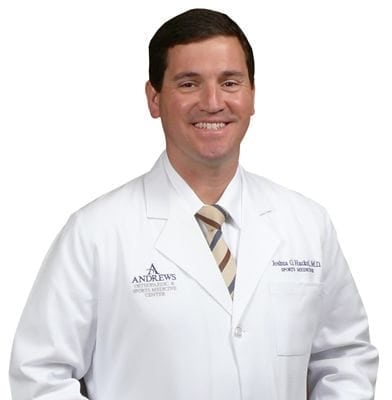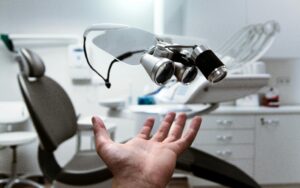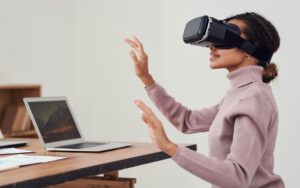Sports Medicine is changing quickly with awareness of head trauma, youth sports overuse injuries, and endurance and full-contact sports problems increasing, one can forgive Dr. Joshua Hackel and his colleagues for being busy these days. Not only does Dr. Hackel treat these injuries, but he also mans the front lines of sports medicine itself.
A golfer, jogger and sailor, Dr. Hackel practices at the prestigious Andrews Institute of Orthopaedic and Sports Medicine in Gulf Breeze, Fla. This is the clinic of Dr. James Andrews, to whom many professional athletes and teams turn and from whom many sports medicine findings originate. Dr. Hackel’s specialties give him a full picture of the present and future: musculoskeletal ultrasound for diagnosis and treatment, non-surgical orthopaedics, and regenerative medicine and injection therapy.
In this conversation, Dr. Hackel discusses today’s sports injury issues, technologies being utilized and developed, and his perspective on the future. He also throws in a few surprises — starting with his first answer.

INNOVATION & TECHNOLOGY TODAY: How have sports injuries changed in the last 10 years?
DR. JOSHUA HACKEL: Not only are they becoming more common, but they’re occurring at a younger age. Young people will be training, not for multiple sports like we did when we were children, but for playing one sport yearround. Because of that, their bodies do not have the opportunity to heal. They develop overuse injuries. Whereas we used to see these injuries in professional and college athletes, we now see them in adolescents. We see something like a Tommy John ligament tear in the elbow in a 14-year-old. That was once unheard of.
I&T TODAY: Because these younger kids are not fully developed physically, do these early-onset overuse injuries cause greater harm to their futures?
JH: Absolutely. You have more opportunity for arthritis to develop, limited mobility, things like that.
I&T TODAY: What do you see as the long-term impact if we continue to promote kids playing single sports year round?
JH: Injuries earlier in their careers, and earlier ends to their careers. We actually have the STOP Sports Injuries program that my mentor and partner, Dr. Andrews, and the AOSSM (American Orthopaedic Society for Sports Medicine) have developed. It’s a prevention awareness program, so coaches are more aware of the consequences of overtraining their kids.
I&T TODAY: Have you seen an increase of injuries, or severity of injuries, arising from hard contact sports such as MMA or extreme sports?
JH: Yes. It comes to the same point as with the young one-sport athletes: they don’t have a period of rest. The body doesn’t have an opportunity to heal, so the aggregate of participation will cause the tendon or muscle tissue to break down. They are injured more often.
I&T TODAY: What about types of injuries?
JH: I wouldn’t say they’ve necessarily changed. I would say we recognize the complexities of individual injuries Innovation & Technology Today Conversation with better, because we have such better diagnostic capabilities, as compared to previously.
I&T TODAY: Non-invasive surgeries have been a blessing for all of us. Could you discuss how diagnostic tools and improved imaging have gone hand-in-hand with the ability to perform more arthroscopic and laser surgeries?
JH: With ultrasound, you can see tendon tissue with much greater detail than with an MRI. You can also see these lesions dynamically. In other words, you can see a tendon moving in the soft tissues. Before, with an MRI, it was a static image. You can’t see tissues gliding dynamically like we can now. The desire of the public to have minimally invasive surgeries has really pushed ultrasound technology to the forefront, to develop less invasive technologies.
I&T TODAY: How have refinements in technology, imaging and diagnostics enhanced your approach to rehab and therapy?
JH: The importance of rehab with minimally invasive procedures has always been magnified. We’ve always recognized that physical therapy after the surgery is just as important as the surgery itself. You can have the greatest surgical procedure, but without proper physical therapy, the outcome of that procedure will be less than you had hoped for.
I&T TODAY: Have you seen an increase in treatment for plantar fasciitis, Achilles tendinitis, and other heel and foot injuries in recent years?
JH: Yes. It’s ironic. My father and my wife currently have plantar fasciitis, so in that respect, I see a lot of it at home (chuckles). A lot of people are recognizing the importance of physical exercise. Adults are becoming more and more active. For that reason, and the popularity of endurance sports, we’re definitely seeing an increase in endurance sports injuries, such as plantar fasciitis.
I&T TODAY: Let’s switch gears. You’re also working with stem cell therapy. Could you elaborate on that?
JH: We are researching how to utilize the patient’s own stem cells in order to accelerate the body’s natural healing. We’re using mesenchymal and endothelial stem cells in order to do that. We’re doing it for multiple injuries, from tendon and muscle tears to arthritic joints.
I&T TODAY: How have the results been thus far?
JH: Very good. We don’t really promote stem cell therapy; the appropriate research still needs to be conducted. I can tell you that we’re seeing great results with the utilization of the patients’ stem cells to accelerate healing. I think the future of orthopedic sports medicine lies in regenerative medicine, including stem cell therapy. We’re just scratching the surface.
I&T TODAY: What do you see as breakthrough findings and technologies in sports medicine in the next three to five years?
JH: Musculoskeletal ultrasound has been an incredible advance in sports medicine. It’s every bit as important to a sports medicine physician as the stethoscope is to a cardiologist. We don’t rely solely on the radiologist anymore to get us the interpretation of an X-ray or MRI. We’re performing ultrasounds here to diagnose pathology and accelerate a treatment plan from the first visit, and also to diagnose pathology that was going unrecognized prior.
I&T TODAY: Will musculoskeletal ultrasound technology continue to refine hand-in-hand with your ability to make new and better diagnoses from it? Will one drive the other?
JH: Absolutely. We recognize the importance of precise injections. Ultrasound allows us to inject soft tissues precisely. We’ll see even more findings in which we start recognizing things we didn’t even know existed in our body that could be isolated, harvested, and used to treat multiple soft tissue injuries.
— Robert Yehling









